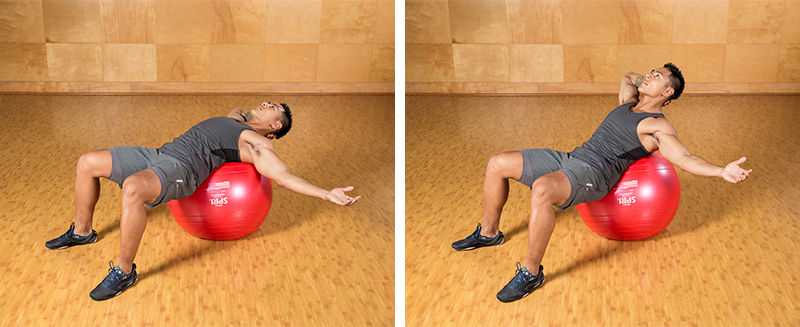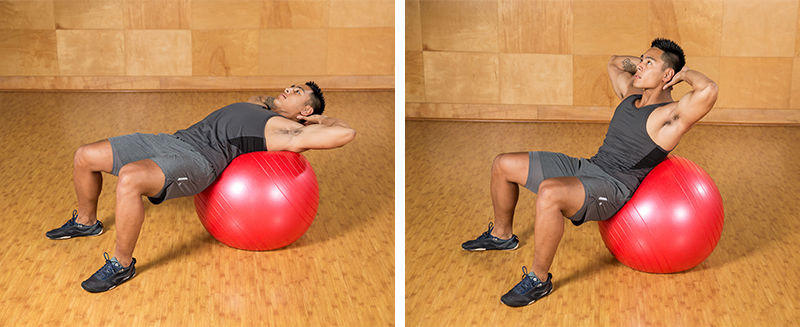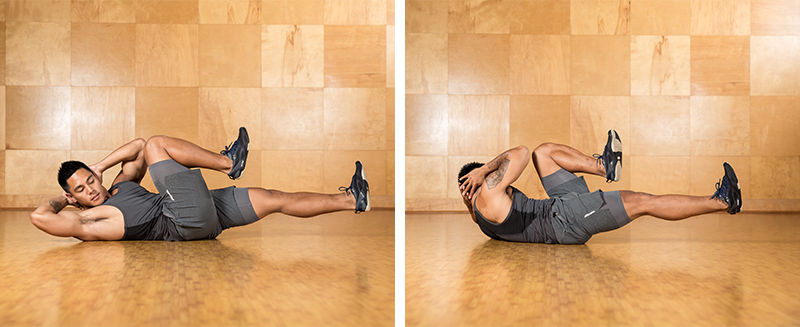It’s safe to crunch again.
Not too long ago, a good number of well-meaning, but misguided people stirred up enough fear around crunches that many people were scared to do them and were encouraged to do planks instead—and now the new world record for a static plank that is more than eight hours. That’s not a typo.
Abdominals are always a popular workout topic, so it’s a perfect time to revisit crunches with some tweaks to make them more beneficial for your core. Here are four variations for you to try and incorporate into your abdominal training workouts.
Semi-vise Crunch
Equipment: Stability ball
Lie on your back and lift your right leg in the air slightly, placing the ball on your thigh just above your right knee. Gently hold it in place with your right arm by placing your open palm on the front of the ball.
- Use your abs to simultaneously lift the leg that is under the ball and your upper torso from the floor. Maintain tension on the ball with your hand and keep your arm straight.
- Continue raising your leg and your torso. The ball will naturally roll up your leg.
- Slowly return to the starting position. Lower your leg almost all the way to the floor.
Performance Tips: Your arm and leg form something like a “vise” that holds the ball in place on one side of your body. You can control the intensity of the contraction in your abs by changing how hard you press your hand and leg against the ball. Keep your arm straight throughout the entire movement.

Offset Arm Crunch
Equipment: Stability ball
Place one hand behind your neck and the other hand out to the side, holding your arm straight and your palm turned up toward the ceiling. This position increases activation of the inner abs and the obliques to keep you positioned on the ball. Your arm position creates a weight imbalance that your abs must counteract to keep you on the ball.
- Use your abs to lift your chest up and forward in a crunching motion.
- Stop when you feel the tension in your abs decrease.
- Slowly return to the starting position.
Performance Tips: Perform the crunch by moving your torso as you would if you didn’t have one arm out to the side. Keep your hips and shoulders squared—you should not rotate your torso at all.

Offset Torso Crunch
Equipment: Stability ball
Place both hands behind your neck with the elbows bent and out to the sides. Shift slightly to your left to position your torso slightly off the middle of the ball. This position increases activation of the inner abs and the obliques, just like with the Arm Offset Crunch above. However, this variation is even harder and brings more challenge to all of the abdominal muscles, because your entire torso is shifted rather than just your arm (which is lighter than your torso).
- Use your abs to lift your chest up and forward in a crunching motion.
- Stop when you feel the tension in your abs decrease. Your shoulders should almost be over your hips.
- Slowly return to the starting position.
Performance Tips: You should still perform a crunch, moving just as you would if you didn’t have your body shifted slightly out to one side. A small amount of rotation is unavoidable; your aim is to minimize it.

Bicycle Crunch
Equipment: None
Lie on your back with your left knee bent and drawn up toward your chest. Your right leg should be straight and lifted off the floor. Place your hands gently behind your neck or the lower part of your head. Your elbows are bent and out to the side.
- With your left knee bent and your right leg straight, lift your right shoulder off the floor and move your right elbow toward your left knee.
- As you return your right shoulder to the floor, begin to extend the left leg while simultaneously bending the right knee and bringing it in.
- As the right knee moves farther in, begin to lift your left shoulder off the floor and to move your left elbow toward your right knee.
Performance Tips: The old-school, gym-class version of the bicycle crunch barely worked the abs at all. It usually consisted of lying on your back and kicking your legs furiously while pulling your head forward and rotating it vigorously from side to side. Instead, go slowly and lift your shoulder blades off the floor. When you bring your shoulders down, touch them to the floor but do not rest them there. This maintains constant tension in your abs.

Wrap Up
As you incorporate these exercises in your fitness programs and abdominal training, aim to complete between eight to 20 reps. These variations turn on more of your abdominal muscles and require you to do them well in order to do them at all, which means you will get more benefit from your workout time, while avoiding the extremism of never doing crunches.




 by
by 










 by
by